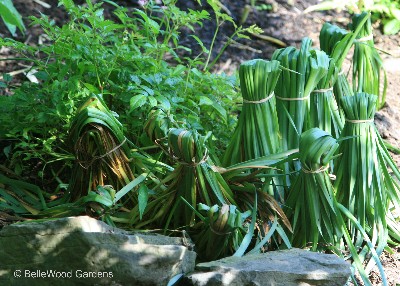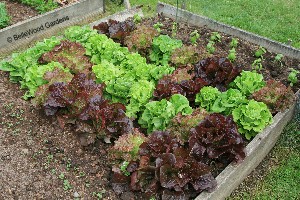
Seasonal Care of the Garden

Prune dead or crossing branches, and also prune as necessary for shapeliness.
Pruning at this time of year reduces suckering and water shoots.
Stake perennials as needed before they fall over, become damaged or broken.
Deadhead perennials such as peonies and iris as their flowers fade.

Showy flowers are a plant's means of advertising for pollinators. Once the sexy transfer
of DNA has been accomplished, petals drop & fade away. As gardeners, most of the time
we want photosynthetic energy back in the plant, not expended on seed production.
That's why dead-heading is important for more than just tidying up the garden. Do it
early, before the flowers fade and you'll have a wonderful bouquet to enjoy. Nice!

Mulch garden (if not done previously) to hold in moisture and help keep down weeds.
Cultivate for weed control in areas of garden not mulched.
Pinch chrysanthemums and fall asters. If you haven't been doing this already, pinch back hard, by one-third.
Finish planting tender annuals such as impatiens and coleus
Move houseplants outdoors to sheltered, partly shaded area for summer vacation.
Fertilize annuals monthly but only if a slow-release, long-term fertilizer was not used at planting time.
Allow leaves to mature on hardy bulbs (daffodils, hyacinths etc.) Do not bundle, braid, or otherwise confine leaves.

Spring flowering bulbs are in growth for such a short time that
a prudent gardener will do all she can to ensure that their leaves
manufacture as much in the way of nutrients as possible,
for better bloom in the following year. When leaves are
tied up or otherwise restricted this just doesn't happen.
Plant tender bulbs such as dahlias, cannas, and caladiums.
Harvest strawberries. Harvest peas when pods are plump. Harvest any remaining cool-season crops (lettuce, radish etc.)

Continue sowing heat-tolerant crops such as beans and sweet corn.
Sow heat-resistant varieties of spinach, lettuce, kale etc. every two weeks for continuous harvest.
Since spinach originated in Persia (now Iran) you'd think it would be somewhat heat tolerant.
The smooth or round-seeded inermis types tend to be slower to bolt in warm weather.
Alas, modern spinaches have cris-crossed parentage and the differences between spiny-seeded,
cold-hardy, early-maturing oleracea varieties and inermis types have become blurred.
Heat-tolerant Malabar and New Zealand spinach look like true spinach, but don't taste like it.
Some heirloom lettuces can tolerate a bit more heat than other lettuces. Mid-day shade
is also helpful in extending the salad season. Use window-screening on a raised frame
or supported on hoops. Leaf lettuces such as black-seeded Simpson or oak leaf can also
offer an extended harvest, as is 'Merveille de Quarte Saisons', a bibb-type lettuce.
Chinese kale or Gai Lohn, Brassica oleracacea alboglabra is heat resistant,
with edible stalks, young leaves and buds. Sow seed in early or late summer. Easily grown.
When white buds are formed cut stalks 6- to 8-inches from the top of plant to force new growth.
Cook stalks leaves and buds all together like broccoli for a most appetizing vegetable.
Early in month finish planting long-season warm weather vegetables such as tomatoes, peppers and eggplants.
Set out cutworm collars at planting time.
In late June, stop picking asparagus, and fertilize.
Trellis vine crops such as cucumber and winter squash if you have not already done so.
Mow regularly, removing no more than one-third of the grass blades.
Frequent mowing means you can leave clippings on lawn, returning nitrogen to the soil.
If rainfall is less than one inch per week, (you may ignore this in 2009!)
water heavily twice a week on loamy soils to make up the difference. Clay soils
need less, while sandy soils require more, and more frequent, watering.
Fill containers mid-month. Allow to stand for a couple of days to let water warm
to 70° Fahrenheit, which also removes chlorine if city water is used.
Add potted water lilies, other aquatic plants, and submerged oxygenating plants.
Fertilize with balanced slow-release fertilizer developed for water plants.
Take greenwood cuttings to propagate azaleas later in month. Here's how:
Take half-hardened shoots of new growth.
This can determine half-hardened by snapping shoot.
If it breaks, but hangs by a strip of bark it is at the right stage.
Using sharp clippers cut shoots with 5 pair of leaves.
Strip away lowest 3 pair of leaves.
If you have rooting hormone for woody plants, use it. If not, don't fret.
Set cuttings in 50:50 mix of sand and peat moss. Should be damp but not soggy.
Cover with plastic bag supported on chopsticks so plastic does not sag onto leaves.
Set in bright but sunless place such as the north side of building.
Leave for 6 to 8 weeks, then check for rooting. Tug gently, resistance = rooting.
If well-rooted, pot individually in equal parts good soil and (peat moss+ sand)
OR plant into holding bed or cold frame, in soil amended with compost and sand.
NOTE: This technique is very good for azaleas, does not work with rhododendrons.